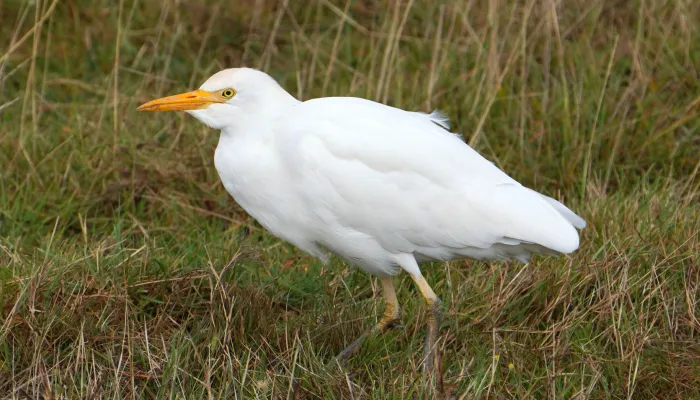| Statistics | |
|---|---|
| Length: | 50cm |
| Wingspan: | 93cm |
This small, white heron is an increasingly common sight in parts of the UK as it spreads north from continental Europe.
About
As the name suggests, cattle egrets can often be seen close to cows, as well as other large grazing mammals. They follow the larger animals around, feeding on the insects and other invertebrates that they disturb. Studies of the diet of cattle egret in other parts of the world have revealed that crickets and grasshoppers are one of their favourite foods, though they will feed on a wide variety of prey, from ticks to frogs. Cattle egrets are sociable birds and prefer to nest in colonies, often mixed in with other herons.
Cattle egrets have shown one of the greatest range expansions in the world of birds. At the beginning of the 20th century, the western form of cattle egret was only established in southern Spain, Portugal and North and tropical Africa. Over the next few decades they spread south to South Africa and began to spread north across Europe. They even managed to cross the Atlantic to reach South America, and have dispersed throughout that continent and up into North America, with breeding recorded as far north as Canada.
Only a few decades ago, cattle egrets were still rare visitors to the UK, until a large influx over the winter of 2007/2008 saw over 200 birds recorded here, mostly in south-west England. This led to the UK's first record of breeding cattle egrets, with at least two pairs nesting in Somerset in the summer of 2008. Since then, they have become an increasingly common sight in the UK and, although still a rare breeding bird here, have nested in several other counties and look likely to become more established.
How to identify
A small, white heron. Cattle egrets are only slightly smaller than a little egret, but with a shorter neck, shorter legs and much more compact body giving them a stockier impression. They also have a shorter, stubbier bill, which is dark in juveniles but quickly turns yellow.
Young birds and adults in winter are all white but in the breeding season the adults show bright orange-yellow feathers on the crown, lower back and chest. These brighter feathers can be visible from spring well into autumn. The yellow bill also turns a brighter red-orange during the breeding season, and the dark or greyish-yellow legs take on brighter yellow and then pinkish tones.
Did you know?
There is also an eastern race of cattle egret that has expanded its range throughout Asia and south to Australia.

